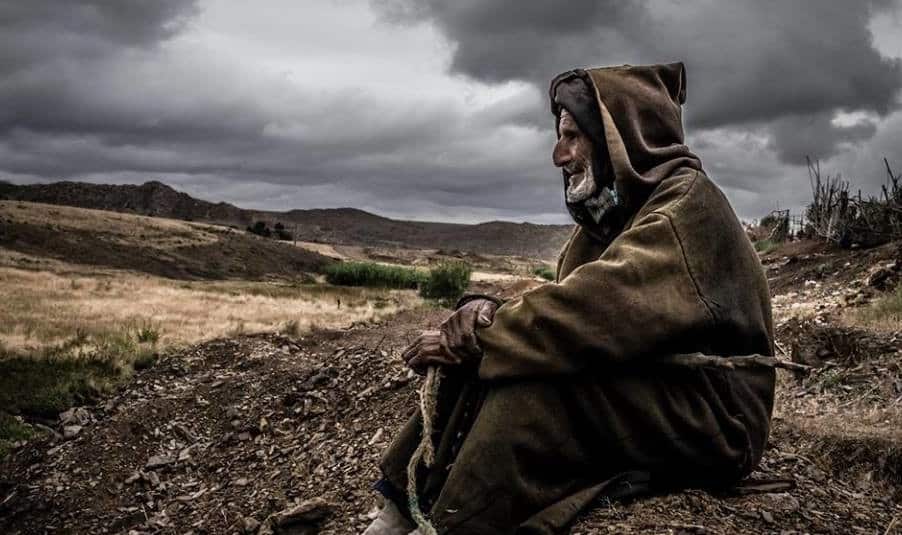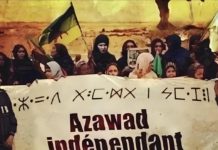“Without music, life would be a mistake.” Friedrich Nietzsche, Twilight of the Idols
[dropcap]A[/dropcap]mazigh people (Berbers according to Romans) are the aboriginals of North Africa from The Siwa Oasis in Egypt to the Atlantic Ocean including Libya, Tunisia, Algeria, Morocco, Mauritania, Mali, and Niger. Despite all the different attempts from different invaders to exterminate Amazigh identity from North Africa, the natives still preserve their own culture and language, with all its dialects to the present time. Arabization is a new form of oppression they still resist. Oppressing people differs from country to another. Tamazight, which includes all the dialects of the Amazigh language, was also repressed and even banned from use in institutions and in public spaces. In the past seven years, the Moroccan constitution was the first to acknowledge the Amazigh language in North Africa. Yet, it is still not really in use in official documents, on signs and so forth, the situation is even worse in other countries.
As for Amazigh music, diverse Amazigh musicians can be found performing worldwide. Bombino band and Tinariwen from Mali, who belong to Tuaregs, the nomadic Amazigh in the Desert are few well-known examples. Their music is a mixture of African rhythms and sounds influenced by rock-and-roll and blues. However, when it comes to North Africa mainly Morocco, we find that Izenzaren band contributed a lot to this music by embracing universal rhythms and topics.
Izenzaren was able to be one of the leading bands of Amazigh music thanks to its revolutionary rhythms in which the moans and the groans of the wretched are voiced out. Its power is of three dimensions: the first is voicing out the suffering of the marginalized people, the second is the authentic rhythms, and the third is the spirit of the period (early 1970s) which was influenced by the Beatles. Izenzaren has a sense of adventure toward the unknown due to identity crisis which was an outcome of egocentric dominance of the State vis-à-vis the natives of Morocco and their identity. A wound that gave birth to a challenge which the traditional Amazigh poets articulated its layers, express its content, and passed it to young musicians who beautifully transformed it to touching rhythms using different instruments.
As new experience, Izenzaren came to link the youth with their Amazigh roots but without imprisoning one’s self in the past. It also came to put Amazigh identity to question. The latter was and still is at the center of its experience. Izenzaren strongly asserted the existence of Amazigh identity. By so doing, Izenzaren incorporated many different instruments such as banjo, violin, drum, guenbri or hajhouj, and qarqaba.
Amazigh music addresses all elements of life and human experience. Its major constituents are the romantic, the social, and the political. Because Izenzaren is a committed, intellectual and philosophical tongue, it was very normal that the band was elected to be the voice of the wretched in the world in general and in Morocco in particular. It called for the purification of the self and social justice.
One should note that Izenzaren members are students of the traditional school of Amazigh poets and musicians whose talents were shaped by Amazigh oral culture in North Africa. On the other hand, Izenzaren was able to transcend the traditional school and create a whole new phenomenon called “taznzart”, a transition that put them on the top of the modern Amazigh music.
Abdelhadi Igout, the head of the band, has embraced many musical instruments including banjo and violin since childhood. Instruments that he made with his own hands using simple tools, he kept telling these instruments his secrets by the shores of the Atlantic Ocean and in his neighborhood. This led him to meet many talented people who shared the same sufferings and hopes and who later formed the band which was an exception in North Africa in general and in Morocco in particular.

This experience was a clear answer to a new generation of youth in early 70s, who migrated from rural areas of morocco to big cities, and whose language was Tamazight. That youth could no longer find their prey in the traditional school because they neither shared the same symbolic code with the traditional musicians nor did they share the same vision toward the world, and probably the same was happening in Algeria at that particular time especially in Kabyle region, the area that gave birth to the international Amazigh singer named Idir.
Izenzaren is ground-breaking phenomenon that played a great role in promoting Amazigh culture and Moroccan music by embracing world rhythms and by implementing many musical instruments. The echoes of Izenzaren, the Beatles of Morocco, reached Europe and pushed them to participate in many international festivals in which they proved their outstanding talents. This explains the fact that Amazigh artists don’t lack the talent to give to the world. What they really lack is financial support as well as the institutional encouragement. Izenzaren fertilized Amazigh music and its music will surely be tattooed in the Moroccan memory for ever and ever.

















